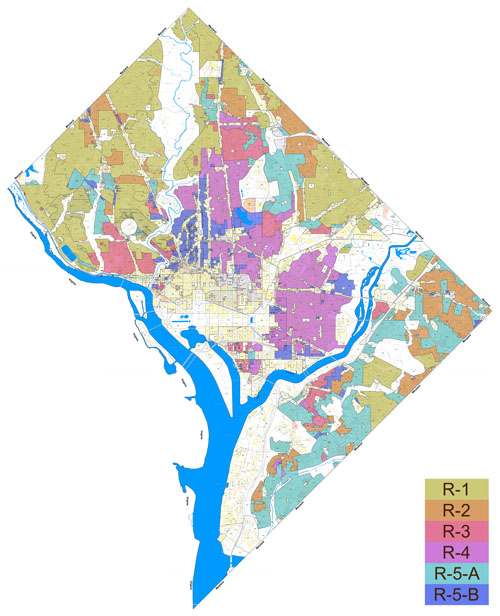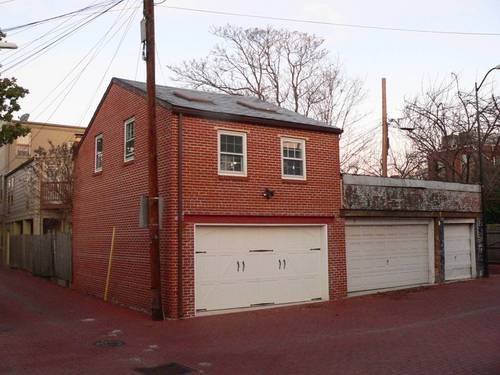DC’s move to legalize a little more housing (and other zoning changes): The finish line is in sight!
If you want to rent out a basement or garage and can’t today, you might be able to by the end of 2016. DC’s long-running zoning update finally got, um, “preliminary final action” approval at a meeting Monday.
The zoning update, in a nutshell, does two types of things. First, it will completely overhaul the District’s zoning code to be more modern and, at least in theory, more understandable. Second, it makes a few targeted policy reforms, like allowing buildings near transit to have less parking if the owner doesn’t think it’s necessary, or letting homeowners in low-density areas rent out a basement or a garage or other space in a home to make some extra money and provide more housing.
Other changes let grocery stores possibly locate in residential areas as long as they’re on corners and comply with a raft of other limitations; make it easier for theaters to operate in church basements and elsewhere in residential zones, subject to a public hearing; expand the area where certain downtown zoning applies; and a plethora of other small tweaks.
Advocates of keeping the cost of housing reasonable have been eager for the provisions to allow renting basements and garages (accessory apartments). Doing so creates the potential for more housing, and lower minimum parking requirements, which reduce the cost of building housing. Unfortunately, these efforts, which gained general Zoning Commission assent in 2009, have been waiting since, while the DC Office of Planning in the meantime pushed through other zoning changes that reduced potential new housing.


Good changes got caught up inside bigger, harder ones
One reason the zoning update has been delayed so many years is because a new zoning code is certainly intricate. The Office of Planning’s former staffers who ran the zoning update back in 2008 may have made a tactical mistake in coupling key policy changes together with the new code in its complexity; anyone uncomfortable with the scale of such an undertaking balked at parts of the process even if their intent was not to hasten the rise in housing prices.
For example, several neighborhoods now have “overlays” which add special zoning rules on top of the base ones for similar areas. The new code instead sets up new base zones for each area with an overlay, so property owners don’t have to look in two places and reconcile conflicting rules. But to people familiar with the old code, this is initially confusing, and the new approach has some cons along with the pros.
Coupling the important policy changes with technical ones like this hooked the effort to add housing to a very slow caravan. This afforded more chances for opponents of the actual changes to lobby to water them down. Politicians nervous about adding housing could couch concerns in the language of confusion or community engagement more readily.
The changes to accessory apartments and parking minimums are valuable, if too little on their own to make much dent in DC’s housing needs which have grown since 2008. Had these more modest changes passed in 2010, say, it could have moved the ball forward and given people a chance to demonstrate these changes don’t cause calamity. Accessory apartments would not have brought criminals into a building or engendered elder abuse, as some of the more strident opponents claimed; buildings with less parking would not have brought carmageddon.
The zoning board says, let’s go
Much of the public opposition, at this point, is not really about substance, but process; the Committee of 100 argued that the code needs a third party review (and, of course, substantially more delay). Ward 4 councilmember Brandon Todd asked for another month’s delay. But DC’s Zoning Commission, the hybrid federal-local board which makes the final decisions on zoning, has had enough of this process after eight years.
Chairman Anthony Hood did repeatedly express that he was “nervous” about signing off on a new zoning code. He worried about having to stand in front of Costco (which is relatively near his home) and defend the new zoning code to neighbors. He bit at the Committee of 100’s independent-review idea, but the other commissioners felt the time for that was long past and the code was ready for approval.
Well, almost: The Office of Planning still has to make a few more small, mostly technical tweaks and present a final version. The commission will consider taking “final final” action (versus this week’s “preliminary final” action) on January 14, but there will be no more testimony in the meantime.
Also since the last revision, OP has backed off somewhat on its plans for alley lots; there will have to be a hearing before alley lots can get housing, while previously OP was proposing allowing one dwelling unit on such a lot without a hearing.
If approved in its final form, the Office of Zoning, which administers the zoning code, will publish it in the DC Register, and then six months later, the new zoning code will apply. Anyone applying for a building permit before that date will use the old code; after (with a few exceptions), the new one.

Residential zones as of 2008. Accessory apartment rules apply to R-1 (yellow), R-2 (orange), R-3 (red), and R-4 (purple). Image by David Alpert from Office of Zoning base map.
Change may be less than a year away!
This means that if you live in one of the low-density areas of the city (generally, detached houses, or houses in pairs which share one wall — yellow and orange in the above map, or a very small set of areas with row houses that are categorized R-3 today, red in the above map) you will be able to rent out a part of your house as a separate unit, with a variety of restrictions, but without having to go through a public hearing.
If you live in one of those areas, or a moderate-density row house area like Columbia Heights or Capitol Hill (purple in the above map) and you have a garage, you will be able create a unit in that garage. However, you will still have to show up at a public hearing where neighbors will be able to oppose (or support) the idea, and will probably need a zoning lawyer to navigate that process.
A few buildings will be able to get built with less cost. A few corner groceries may appear in some residential areas. It’ll be a significant, but small and long-awaited, step forward.

